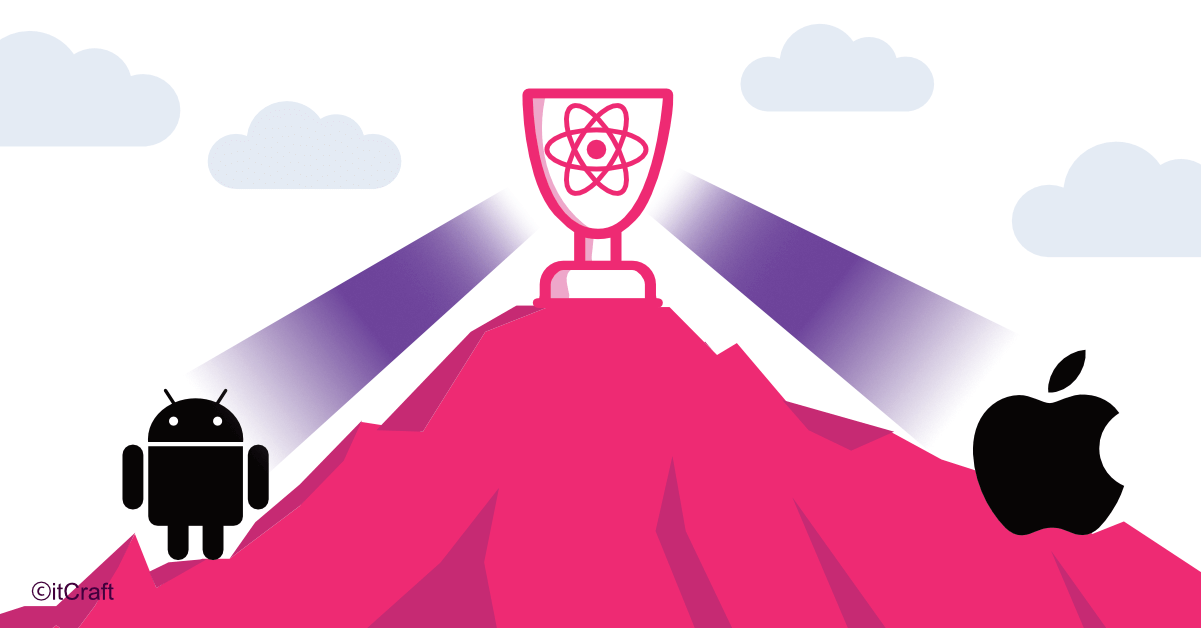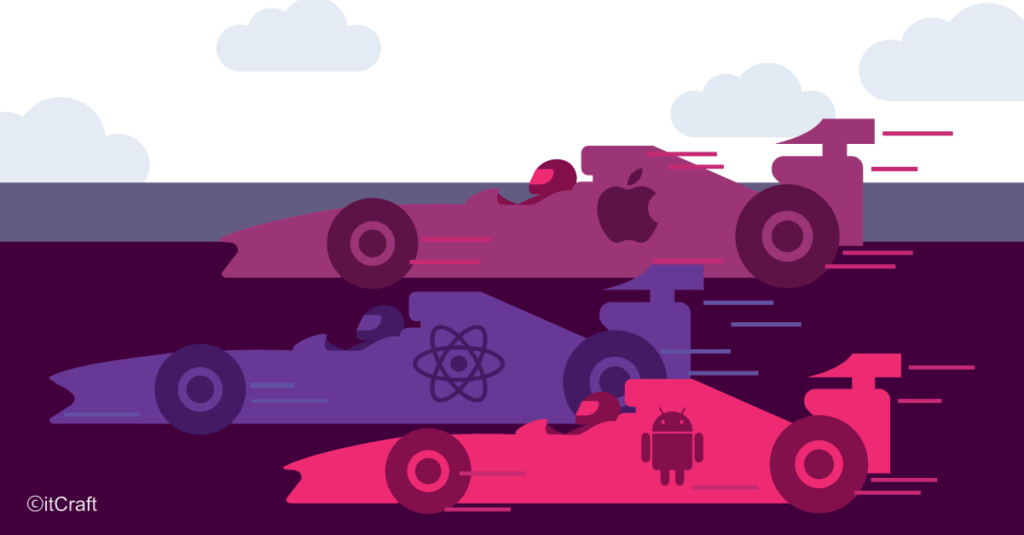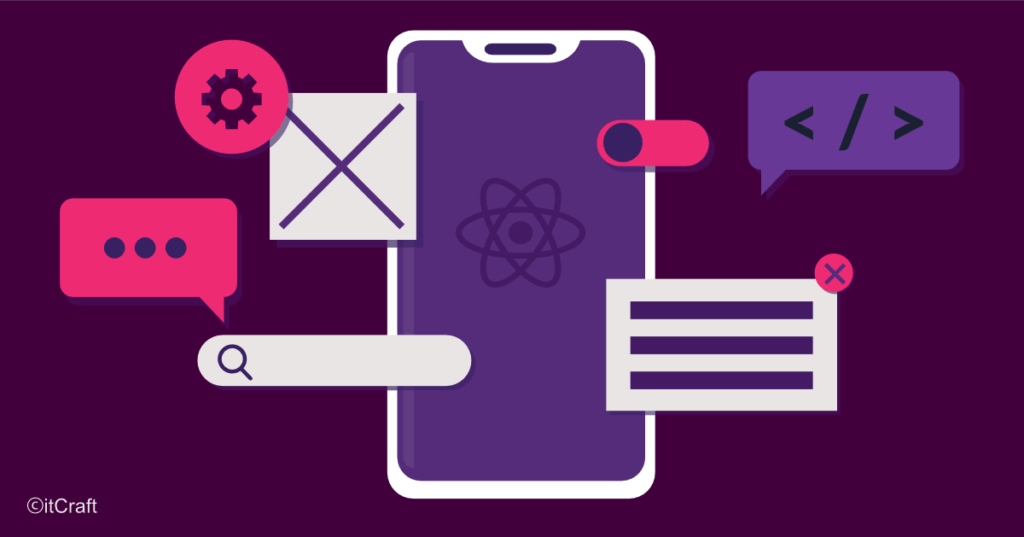Is React Native the ultimate Holy Grail of mobile app development?

Paweł

App development for mobile devices is a story of diversity. iOS, Android although currently hold the duopoly in the market, up until recently had Microsoft and Blackberry for competition. From a user’s point of view, this competition is reduced to a choice between devices and
Table of contents
- Native rules, but not forever
- Unify and conquer?
- Why look for cross-platform technology then?
– Cross-platform development is not a new idea
– People’s vote matters
– React Native in a nutshell
– Hiring now!
– Savings without (too many) compromises
– A pill for customers’ headaches
– An app is more than just code
– A positive compromise
– Not for everyone just yet - The art of making everyone happy
Native rules, but not forever
Today, app development is predominantly native, meaning that developers, when tasked with creating an app, must possess a skill set for all platforms the app is supposed to work on. Hiring both iOS and Android developers is currently the way to ensure customer’s needs are met.
The price of developing essentially 2 separate apps, the time required and the specialists engaged in the process are posing a significant challenge and forcing the community of software developers to look for alternatives.
Unify and conquer?
The most desired solution would be a technology that enabled single production for all platforms. A cross-platform technology is the ultimate Holy Grail of mobile app development. Attempts have been made to create such a tech, but few come as close to ticking all the boxes as React Native.
The superiority of native apps still remains unshaken. Developing software on dedicated frameworks has obvious advantages. The effecting apps utilize the unique hardware capabilities of devices, are faster and designed according to what the device can accommodate. The User Experience benefits greatly from apps being built for dedicated systems.
itCraft delivers innovative software solutions in React Native. We have both the skill set and experience to help you create a perfect app for your business. Contact us now to learn how to save time and money by choosing React Native development.
Why look for cross-platform technology then?
On the one hand, it’s about money. Developing apps is a costly venture. If we’re looking for just an Android or iOS software then going with native development is an easy choice. Developing a single platform app requires one set of specialists and one code to be written. Testing, maintenance, and further development are quite straightforward.
If we are developing an app for both iOS and Android platforms, the costs start growing. Developing two sets of native components, two separate User Interfaces that are supposed to look and work the same, ensuring the app “feels” the same for users of both systems, while retaining the platform-specific traits – all these need specialists to create them.
Follow our blog to find out more about pros and cons of react native vs native development.
Cross-platform development is not a new idea
React Native is not the first, nor will it be the last take on cross-platform development. Xamarin (currently 2.0) for example, a C# based platform, made it possible to develop native Android, iOS and Windows applications from Visual Studio. Most of the common code here is written in C#. Java, Swift knowledge is unnecessary to achieve most of the real native functionalities. Xamarin tools allow accessing most iOS and Android APIs in C#.
Interested in Java? – Read about API development in Java on our blog.

The solution was acquired by Microsoft in 2016 and has since gained popularity, especially among big brands like 3M, HP or Target which used the technology to make their apps. Although popular among big brands, Xamarin is still considered a niche solution among developers.
React Native is a technology invented by Facebook. Initially, React JS library was used for developing the Facebook platform and amassed a significant community of developers. That, and the ever growing popularity of mobile apps gave rise to the idea of a cross-platform native development. A tool was conceived that would appeal to the community by being familiar and effective.
People’s vote matters
Recent years gave a sharp rise to React Native`s popularity. It is seen as a valuable alternative to native developments. The appreciation is coming from all sides. The developers themselves, software houses and clients are all finding advantages in the solution. Building truly native mobile apps, not a hybrid, web, or HTML5 apps is the main selling point of the solution.
Starting with developers, it’s actually vital for a new technology to gain a footing here. Even the best-designed solution is worthless if it isn’t backed by a community. Coders well versed in JavaScript quickly took a liking to React Native development. There is already an impressive choice of available open source components, both Facebook and the React Native community keeps the technology alive by continuously contributing to its growth.
React Native in a nutshell
At the core, React Native SDK allows building native UIs for both iOS and Android using declarative components with React and JavaScript. React Native library enables moving of business logic (functionality) to JavaScript. Thanks to this approach the programmer needs to implement functionality only once and it will be included in both Android and iOS applications. React Native doesn’t force programmers to write only in JavaScript. Library offers an interface to add native code to the application. It can be useful when dealing with computationally expensive calculations and the need to make them faster with native code. Another possibility is to interact with the native system in a way that is not included in the React Native library.
Hiring now!
Adding to the attractiveness of React Native is the fact that currently, in 2018, specialists in the field are highly sought after. To the extent where universities’ IT departments are regularly visited by headhunters looking for, encouraging, and often subsidizing React Native specialists. Senior and experienced developers are basically hired on the spot with, more often than not, attractive remuneration proposals.
Savings without (too many) compromises
The client perspective is perhaps the most significant aspect to consider when talking about React Native. After all, it’s the product owner’s money being pumped into a project and convincing them to part with it on top of the developers’ wishlist.
For a typical, 2018 client looking to develop an app, there are quite a few paths to consider. Native apps, web apps, hybrid development (yuck), cheapo templates etc.. Doing your homework will quickly filter out the inadequate options. As we’re talking serious clients with serious requirements here, all sorts of silly stuff like hybrid or template gets binned on the spot.
Customers today are looking for professional, comprehensive services, straightforward communication, efficiency, effectiveness, deadlines, and budget savings. The good thing about React Native development is its ability to address a number of these requirements.
If the need is for both iOS and Android apps to be created – React Native offers the ability to develop basically 2 separate native applications that share a majority of the code. The development time is thus greatly reduced, requires one production team and a smaller skill set. You can also check 11 applications built with React Native.
A pill for customers’ headaches
For a client, working with just one development team instead of two means easier communication. Addressing a single set of issues is obviously more manageable and less time-consuming. A product owner is not required to follow two separate paths, one for iOS, another for Android, but instead works within a single, well-defined development process. Ensuing improvements to communication, efficiency, and transparency of the app production are of great value.
The popular notion is that since you’re using one process to create an app for two platforms the budget should be reduced by half. This, unfortunately, is not quite the case. At least not yet.

An app is more than just code
The dedicated platform is not the only factor influencing the price of a mobile app. The complexity of the software, UI/UX design, testing, and deployment are all vital parts of the process and the fact of developing in React Native doesn’t offer much in terms of price reduction here.
For example, a graphic designer tasked with creating a “look” for iOS and Android app will need to be paid the same regardless of the code the app is written in.
As of 2018 the actual savings you can make going with React Native are estimated at a level of 20%-30%. With the observed growth of the technology, developers’ careful estimates see that number increasing by another 5%-10% in the near future.
A positive compromise
From a client’s perspective, choosing React Native for mobile app development is still a matter of compromise. Although the technology is growing and improving at a rapid rate, the finished product quality still does not equal that of native development.
React Native would be the weapon of choice for those productions, that need to be developed quickly, efficiently and where there’s little need for extremely high performance and quality.
Not for everyone just yet
VR, AR, 3D, games are not the areas where React Native will beat, or even attempt to compete with Native App Development. Conversely, it does find use in building internal business processes apps, innovative apps that need to quickly enter the market, startup B2C or C2C services. Especially when the speed of development and deployment are of the essence.
Cross-platform development is an attractive new field for software houses. The demand for RN developers is driven by a very effective marketing from Facebook, constantly growing interest of clients and developers themselves. Community support ensures the potential of React Native will keep growing and may soon reach a level of competitiveness putting it on par with market-leading tech.
The art of making everyone happy
App development companies see the value and the growing popularity of the technology. Additionally to native iOS and Android, dedicated React Native teams are becoming a common sight in developers’ offices. The practice is becoming the new standard, and while still quite far from taking over, is on the right track to becoming a major competitor in the app development market.
Is it the Holy Grail everyone’s been looking for? The answer to this is not a straightforward Yes or No. Definitely, though, the outlook seems extremely positive. This coming from pretty much all interested parties. Maybe not quite there yet, but clearly on the right track.
Not the answers you were looking for? No probs.
Drop us a line and we will get back to you with answers to all your queries.
Would you like to know more about differences between cross-platform and native app development? Download our ebook! It is the ultimate guide to Cross-Platform vs Native development. You will find out more about native applications, cross-platform applications and technologies used to build them.






